Ultimate Buddhist Touch (08 Days)
Ultimate Buddhist Touch
08 Days & 07 Nights
All our tours are tailor made tour. We can customize this tour in Sri Lanka to suit your requirements. You can decide where do you want to go and how many days stay in Sri Lanka. As you wish, if you mention the names of the hotels you want to stay, we can reserve it for you.
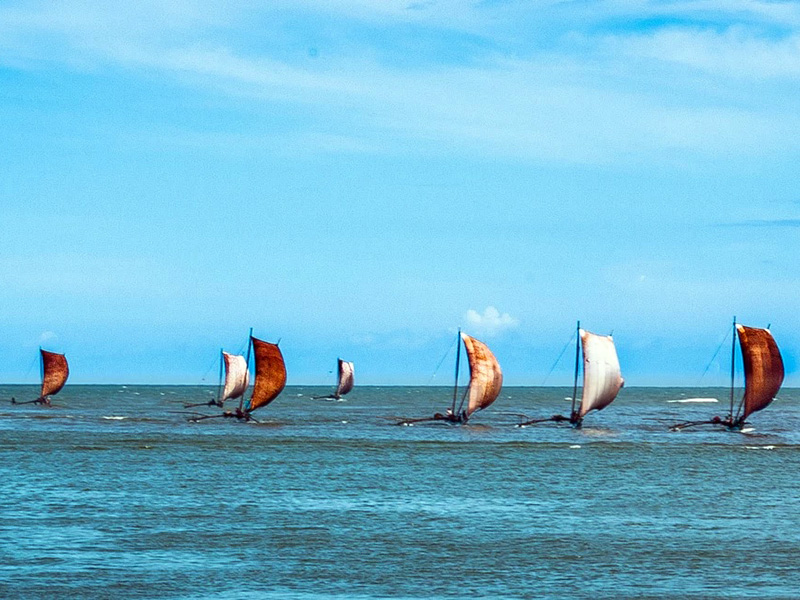
Negombo is a modest beach town located just 10km from Bandaranaike International Airport.Negombo is frequently where tourists spend their first day or two in Sri Lanka resting up after a long and exhausting plane ride. Holiday in Negombo will give you both multiple pleasure and value. The Dutch captured the town from the Portuguese in 1640, lost it, and then captured it again in 1644. The British then took it from them in 1796 without a struggle. Negombo was once one of the most important sources of cinnamon during the Dutch era, and there are still reminders of the European days. Remains of colonization include the Dutch fort built in 1672, as well as centuries-old Portuguese and Dutch houses, Administrative buildings, Churches and the ceiling frescoes of St. Mary’s cathedral church.The facilities for swimming, snorkeling, driving, wind surfing, deep sea fishing and scuba diving. The Negombo lagoon, the sea, the scenic beaches and a large polyglot community inflects the essence of the ultimate Sri Lanka holiday experience. The Dutch canal crossing the heart of Negombo is ideal for making a boat trip. The Dutch canal is the boat house for many thousand fishing boats.
On arrival at the Bandaranaike International Airport, you will get your first taste of warm Sri Lankan hospitality; representative from Aliyah Tours will welcome you at the airport arrival lobby.
Transfer from Airport to Negombo
Negombo is a traditional fishing town of Sri Lanka. The fishermen of the Negombo lagoon live in abject poverty in small, thatched palm houses in villages on the water’s edge. They rely on traditional knowledge of the seasons for their livelihood, using outrigger canoes carved out of tree trunks and nylon nets to bring in modest catches from September through till April.
Negombo is also home to the country’s second-largest fish market, the “Lellama”, at the north end of the town’s lagoon. There are daily fish auctions, which give tourists a chance to meet the area’s fishermen and even organise fishing trips into the lagoon and the ocean beyond. Other nearby attractions open to visitors includes Muthurajawela marshland, which is part.
Being a coastal town, Negombo is housed to thousands of fisherman who actively take part in fishing on a daily basis. The excess catch is being dried & preserved using indigenous technologies. One can visit the area where locals are busy with drying fish & packing them. Well the smell is a part of the experience.

Part hedonistic pleasure palace, part fortress and part sacred complex, Sigirya is one of the island’s most awe-inspiring archaeological sites and a leading tourist attraction. In fact some consider it to be one of the oldest tourist attractions in the world with early visitors recording their impressions as graffiti on a wall described as the world’s first interactive book. Located north of Dambulla, the site consists of a sheer rock that rises over 200m with the ruins of a palace on the top and a vast pleasure garden complex at the foot.
For just two decades in the 5th c.AD, Sigiriya rose to prominence following a power struggle between two brothers, and an act of patricide that saw the then king walled-up alive by his son, Kasyapa. Fearful that his defeated brother would return from exile to extract vengeance, Kasyapa shifted the capital to Sigiriya.
The Megalomaniac yet spiritual Kasyapa clearly had an eye for beauty. The Pleasure gardens include a series of symmetric pools, channels and fountains that still spurt water after 1500 years. Partway up the rock are the famous Sigiriya Frescoes, featuring 21 bare-breasted damsels that may represent celestial nymphs, but were surely modeled on Kasyapa’s own consorts. Halfway you’ll encounter a pair of giant Lion’s Paws, part of the original entrance, which required visitors to pass through the open mount of the lion. The summit yields a dramatic vista of the surrounding jungle and contains the foundations of the palace complex, replete with bathing pool. But all this was to be in vain. Kasyapa descended from his palace in the clouds to face his brother astride an elephant, eventually taking his own life when facing certain defeat.
After breakfast you will transfer to Sigiriya.
On route visit Pinnawala Elephant Orphanage
Those who want to see the tamed and a semi wild elephant in close proximity the best place is the “Pinnawala Elephant Orphanage”. It is located northwest of Kegalle town along the Colombo -Kandy main road. The orphanage is in a beautiful greenish land with fruitful twenty five acre coconut land and having grasses over the underground near Maha Oya. The wide area of shallow water and the huge rocks of Maha Oya make the ideal place to these magnificent animals. Elephant Orphanage was established in 16th February 1975 by the Department of Wild Life Conservation. At the beginning of orphanage there were only five orphan baby elephants those who brought from different places of the island. From the inceptions to date, Neela, Wijaya, Kadira, Mathali and Kumari are some of babies that were brought to the facility still living in the orphanage. Since then orphan elephants brought to the orphanage from different parts of the island and brought up at the orphanage. They were fed with milk as well as array of fodder.
Today the heard has grown up to 69 elephants. Among the many elephants of the orphanage there are three of them which will definitely get your attention.
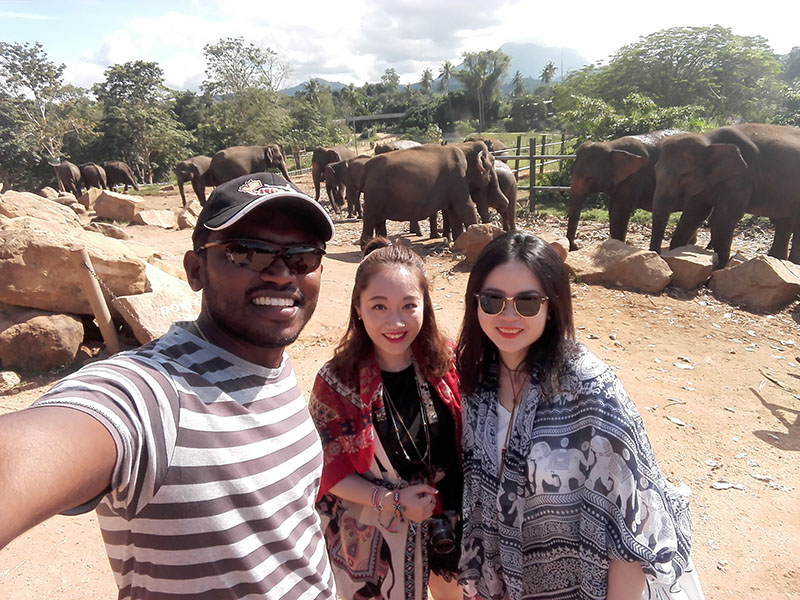

The area was designated as a national park on 12 August 1997, having been originally declared as a wildlife sanctuary in 1938. The reason for declaring the area as protected is to protect the catchment of Minneriya tank and the wildlife of the surrounding area. The tank is of historical importance, having been built by King Mahasen in third century AD. The park is a dry season feeding ground for the elephant population dwelling in forests of Matale, Polonnaruwa, and Trincomalee districts.
May to October is the best time to visit the Minneriya National Park in preparation for the famous wild elephant rally. The vegetation of the park consists of mixed evergreen tropical forests, abandoned oaks, grasslands and wetlands. Among the 24 species of mammals residing in the park are elephants, leopards, lazy bear, spotted deer, deer, wild ox, wild pig, gray leopard, purple leaf monkey, The three species of mongoose, the porcupine and the Indian pangolin. Minneriya National Park has registered more than 170 species of birds. Among the nine species of amphibians in Minneriya National Park are the endemic and threatened thin frog and the common frog. Of the 25-reptile species recorded in Park 8 are endemic, including the Red Lizard lizard. Water and soil monitors are also visible here. The Crocodile Mugger can be seen near the tank. Many freshwater fish species are found in the Minneriya reservoir.
After breakfast at Hotel transfer from Sigiriya to Polonnaruwa
The next great capital which succeeded Anuradhapura and taken up for excavation and conservation by the Cultural Triangle Project is Polonnaruwa. Polonnaruwa was the medieval capital of Sri Lanka from the eleventh to the end of the first quarter of the 13th century AC. However, archaeological evidence suggests that there had been human settlements in Polonnaruwa even as far back as the second century BC. With the development of agriculture, Polonnaruva developed over the years as a vigorous agrarian economy. Both Anuradhapura and Polonnaruva came within the dry zone of the country and one of the formidable tasks the ancient rulers had to face was the conservation of the water necessary for agriculture. It is this exigency that led them to make the large and small reservoirs that lie scattered in the dry zone.
In the fourth century AC, king Mahasena, the great tank builder, built the Minneriya reservoir not far from Polonnaruva. Some other reservoirs in and around Polonnaruva were also the work of Anuradhapura kings. This provided the farmers ready access to the much needed water, which resulted in a flourishing agrarian economy that makes them self-sufficient. King Parakramabahu I combined three small tanks and built the largest reservoir called the ‘Sea of Parakrama’ of which you can have a panoramic view from the lounge of the Rest House in Polonnaruwa.
Today the ancient city of Polonnaruwa remains one of the, standing testimony to the discipline and greatness of the Kingdom’s first rulers. The ancient city of Polonnaruwa has been declared a World Heritage site by UNESCO.
Polonnaruwa is the second largest city in North Central Province, but it is known as one of the cleanest and more beautiful cities in the country. The green environment, amazing ancient constructions, Parakrama Samudra and attractive tourist hotels and hospitable people, attract tourists.
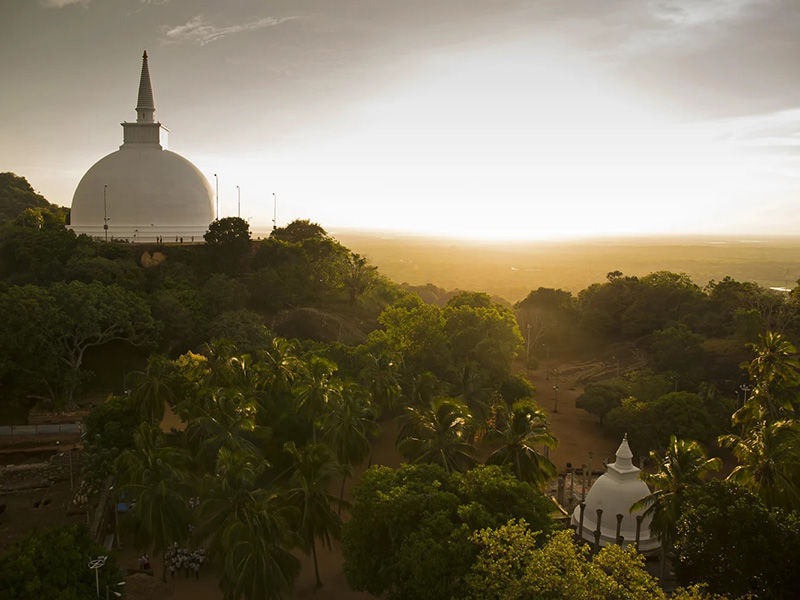
Anuradhapura is nestled between three vast reservaoirs known as tanks – the Basawakkulama, the Tissa Wewa and the Nuwara Wewa. Part of sophisticated irrigation system developed from the 4th c. BC onwards, therse still carry life-giving water to the field in the dry zone, living testament to the engineering skills of the ancient rulers. The raised bunds of the tanks are perfect for an evening stroll and some bird-watching, while also offering great views of the City’s dagobas.
After breakfast you will transfer from Polonnaruwa to Anuradhapura.
King Pandukabhaya was the first Sri Lankan born king and who founded Anuradhapura may have built the fort about the fourth century BC. In fact, even by modern standards, he laid out a well planned city with four suburbs, the Abhaya reservoir, and common cemetery and established a city scavenging service. This UNESCO World Heritage sacred city was established around a cutting from the ‘tree of enlightenment’, the Buddha’s fig tree, brought there in the 3rd century B.C. by Sanghamitta, daughter of Indian Emperor Ashoka, the founder of an order of Buddhist nuns. Anuradhapura, a Ceylonese political and religious capital that flourished for 1,300 years, was abandoned after an invasion in 993. Hidden away in dense jungle for many years, the marvelous site, with its palaces, monasteries and monuments, is now accessible once again.
Sri Maha Bodhi (The Sacred Bo Tree) / Thuparama Stupa
Ruvanveliseya / Mirisaveti Stupa / The Brazen Palace / Isurumuni Lovers / Royal Pleasure Gardens (Gold Fish Garden or Ranmasu Uyana) / The Avukana Lord Buddha Statue / Abhayagiri Monstery / Lankarama / Elephant Pond / Moonstones / Samadhi Stature / Twin Ponds / Mihinthale Rock

Then transfer to Kandy.
On route visit Mathale Aluwiharaya & Spice Garden
The history of Aluvihare Rock Temple is traced back to the 3rd Century B.C to the reign of King Devanampiyatissa. It is believed that the King built the dagoba, planted the Bo sapling and founded the temple after the introduction of Buddhism to the country during his reign. If you move of Kandy to Dambulla, stop in Matale. You will certainly be rewarded for.
Aluvihara; Luminous Cave Temple is synonymous with the teaching of the Buddha. Aluvihara rightly assumes its significance in the annals of the history of world Buddhism. Aluvihare is the place where the Oral teachings of Buddhism, Tripitaka were written into pali on palm leaves. There is a relish story behind the origin of the temple. Especially the cave dedicated to Ven. Buddhagosa thero was used to translate the documentaries and Buddhist teachings.
Visit a spice garden in Matale to see different spices for which Sri Lanka is famous for. Clients will be able to see different spices and how some of these spices are grown and processed. Witness Cookery demonstrations as well.This culinary tour is an ideal way by which the discerning traveler can immerse himself or herself in the history and the ethos of Sri Lanka, its people and their customs and of course most importantly their food. You can learn about Sri Lankan spices and various Sri Lankan cookery methods.
After breakfast at Hotel transfer from Anuradhapura to Dambulla.
Dambulla rock temple has been built in the 1st century B.C. and it is a world heritage site. Also, it is the most impressive of Sri Lanka’s cave temples. Hewn into a 160m granite outcrop are the remarkable cave temples of Dambulla. Located at the centre of the Island and on the main route north to Anuradhapura and Polonnaruwa, the cave temples are masterpieces of Buddhist art. Each is filled with murals depicting scenes from the Buddha’s life, and gilded statues of the Buddha in various poses.
Altogether, there are five caves. A cave 2, the Maharaja Vihara is the largest and most spectacular at over 50m long, 7m high and almost 25m deep. The spiritual energy at Dambulla is palpable and the Buddhist art on display is unparalleled in Sri Lanka. An added bonus is the majestic view from the top of the rock. The complex of five caves with over 2000 sq. meters of painted walls and ceilings is the largest area of paintings found in the world. It contains over 150 images of the Buddha of which the largest is the colossal figure of the Buddha carved out of rock and spanning 14 meters.
Nestled in lush green hills and built around a scenic lake, the Royal City of Kandy, at 500m above sea level, is the hub of any visit to the hill country. Kandy, a UNESCO World heritage Site, was the last bastion of resistance to colonial rule, surviving two centuries of colonial incursions by the Portuguese and the Dutch before falling to the British in 1815. Even today, Kandyans pride themselves on their distinctive architecture, music, dance and art.
The showpiece of the city is the Dalada Maligawa or Temple of the Tooth Palace, which hosts the Lord Buddha’s tooth relic, an item of veneraltion to all Buddhists, is an experience no tourist should miss. Said to have been snatched from the Lord Buddha’s funeral pyre and smuggled to Sri Lanka in the hair or a princess, the tooth relic is of great spiritual significance. Strolling around the lake or exploring the numerous temples that dot the hills nearby is a great way to get the feel of this historic city. Each Year, in August, the city holds the Esala Perahera (procession), a spectacular display of medieval Pageantry replete with caparisoned elephants, whirling fire dancers, and pulsating drummers.
Visit Bazaar area, Arts & crafts centre, a Gem museum and a lapidary etc.
In the evening visit Temple of the Tooth Relic. Late evening witness the Cultural Show, experiencing the pulsating drum rhythms and colorful traditional dances at a cultural show is another must.
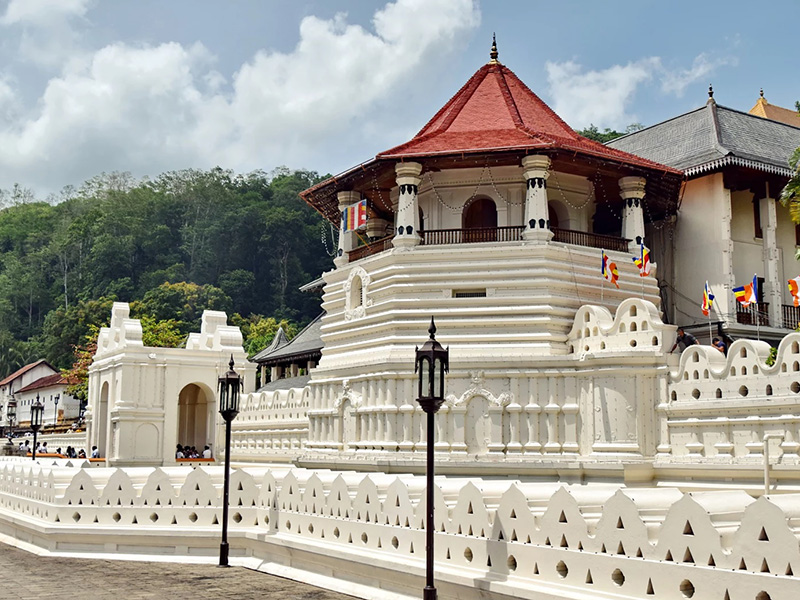
Among the most iconic vistas of hill country are the rolling tea estates that carpet vast swathes of estates that carpet vast swathes of terrain in an emerald sea. Women draped in colorful saris resemble butterflies as they work their way deftly along the tea bushes, picking just two leaves and a bud from each branch and tossing them into the baskets slung on their backs. Introduced to the island in the late 19th century by the British, tea remains of vital importance to the economy.
Some of the finest teas in the world are produced in the hill country and a visit a Tea Factory during a trip to plucked tea is dried, crushed fermented and fired using machinery that has remained largely unchanged since Victorian times. Sri Lanka is world famous for Ceylon Tea. Clients will be shown a tea plantation & a factory. You will be able to witness the processing of Tea and also taste a cup of nice & hot Ceylon Tea. You can buy various different Tea products from the Tea shop.
After breakfast at Hotel transfer from Kandy to Nuwara Eliya
On route we will stop at the Gem Museum & Tea Factory.
Sri Lanka is world renowned for its precious & semi-precious Gems, specially the Sri Lankan Blue Sapphire. It is very unique & owns a huge reputation in the world. Clients could visit a Gemological Museum, a gem cutting factory & also can witness a documentary on Gem mining & the process. Later you can shop for Gem & Jewelry & Other ornaments. Don’t forget to collect your authenticity certificate for gems.
Nuwara Eliya is located at the heart of the hill country 6182 feet above from the sea level. At the heart of the southern hill county is Nuwara-Eliya, Sri lanka’s highest town and a favorite hill station during British colonial times. It is still very much like an old English town with styled Bungalows and buildings. The cool calm climate, gorges rolling tea plantation which makes the best “Ceylon tea” and the breathtaking beautiful waterfalls makes Nuwara Eliya one of the most beautiful town in the world. The town is still touted as ‘Little England’, an illusion maintained by the presence of the finest 18 whole golf courses in South Asia, a racecourse, the Victoria Park and excellent trout fishing in nearby lakes and rivers. The temperature can drop to close to freezing at nights and it is common to se smoke rising from the chimneys of many Tudor-style manors. Adding to the town’s atmosphere is the spectacle of its townsfolk wrapped up in winter jackets and woolly hats, carting great bundles of turnips, leeks, marrows and cabbages to and from the markets. Nuwara Eliya is a great base to explore the surrounding countryside and there are many walks on offer, including hiking around the lower slopes of the thickly forested Mount Pidurutalaga, at 2,555m the island’s highest peak.
You can visit the Golf Club, Strawberry Farms. You can take a nice evening walk around the Gregory Lake. We can arrange horse ride, boat ride and Cycling.
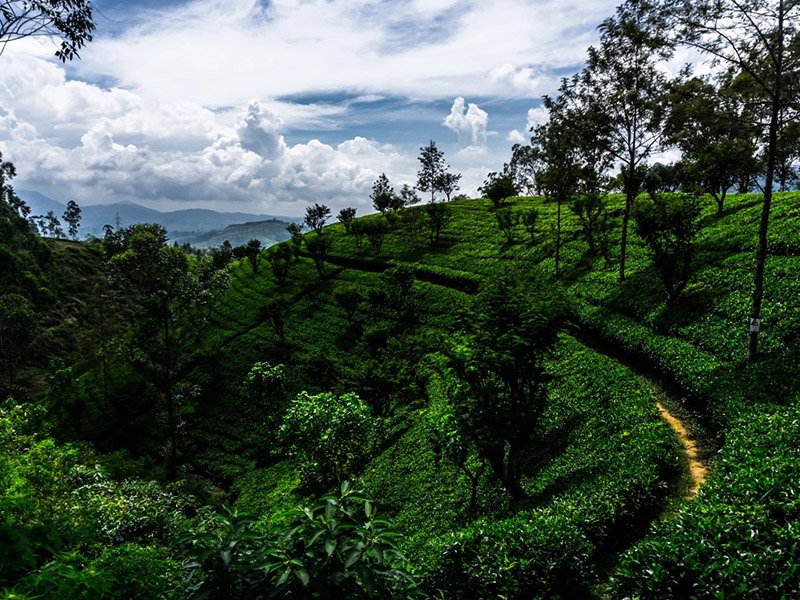
Kiri Vehera is an ancient stupa built by King Mahasena[1] and situated in Kataragama, Sri Lanka. It is 95 ft. in height with a circumference of 280 ft. This structure probably dates back to the 3rd century BC.
Kataragama is a pilgrimage town popular with Buddhist, Hindu, Muslim and indigenous Vedda communities of Sri Lanka and South India. The town has Ruhunu Maha Kataragama devalaya, a shrine devoted to Skanda-Murukan also known as Kataragamadevio. Kataragama is situated in the Monaragala District of Uva province, Sri Lanka. It is situated 228 km ESE of Colombo, the capital of Sri Lanka. Although Kataragama was a small village in medieval times, today it is a fast developing township bounded by jungle in the South Eastern region of Sri Lanka. It also houses the ancient Kiri Vehera Buddhist stupa. The town has a venerable history dating back to the last centuries of BCE. It also was the seat of government of many Sinhalese kings during the days of Rohana kingdom.
After reakfast at Hotel transfer from Nuwara Eliya to Kataragama by train. On route we will visit the Seetha Amman Temple.
British constructed the railway lines in Sri Lanka and today it stands as one of the most scenic journeys to be done on rail in the world. The views on both sides of the rail are breathtaking. The train winds through the mountains overlooking farms and villages and of course vast tea plantations. The scenery changes throughout the trip. Often at times, you are looking out at an entire green view than the next minute you are in the middle of a green forest. The train also passes through several tunnels. As well as often you can see the waterfalls too.
The Demodara Nine Arch Bridges close to Ella station is as picturesque as bridges get. The bridge was constructed in the early 1900’s and is built completely out of rocks and cement without a single bit of steel. The views from the window will have you snapping photos at every turn. Therefore we facilitate our clients to get that experience.
Seetha Amman Temple is located 5 kilometres from Nuwara Eliya. This is considered a prime location in the Ramayana Trail. The temple is situated in the village of Seetha Eliya. According to the Hindu Legend Ramayana, Seetha Amman temple is a unique temple it has been made at the place where Sita was held captive by king Ravana, and where she prayed daily for Rama to come and save her aprox 5000 years ago. It is treated with enduring devotion by Hindus as it is considered to be the only such temple in the world.
Legend has it that Sita, the spouse of King Rama, was locked up in the Ashoka forests of the region. According to the trustees believe that this is no myth and that Sita’s imprisonment at this spot is a historical fact. However offered the following as facts that Sita once stayed in these parts: the concentration of Ashoka trees – various versions of the Ramayana that Sita’s home in Lanka was inside a thick Ashoka forest and the finding about a century ago of three idols, one of which was that of Sita.

Hikkaduwa – Glass Bottom Boat Ride,
Unawatuna Beach – Underwater Diving / Snorkeling / Scuba
Meetiyagoda – Moonstone Mine
Kosgoda – Turtle Hatchery (Sea Turtle safari)
Bentota – Madu River Boart Ride
Ayurvedic Spa
After breakfast at Hotel proceed to Galle. In the evening you can visit Dutch Fort at Galle.
In the evening you can visit Dutch Fort at Galle. The 16th c. Dutch Fort at Galle, close to the island’s southern most point has the distinction of being the best-preserved sea fort in South Asia. Enter through the imposing stone bastions that encircle the sea-facing promontory and step back in time. Inside the Fort you will find that it exudes old-world charm. The narrow streets are dotted with Dutch colonial villas and there’s a welcome absence of vehicular traffic. There are several museums and antique shops that display curiosities from the island’s colonial era. Of the many colonial buildings, perhaps the most absorbing is the Dutch Reformed Church, containing ornately carved memorials to the city’s Dutch settlers. The Fort also hosts some of the island’s most exclusive boutique-style accommodation in former villas restored to their colonial glory.
The Portuguese established the first fort in Galle. This was captured by the Dutch in 1640, after which the fortifications were expanded and the grid street system established. Further extensions were made during the British period. The passenger port gained importance, but with the construction of a breakwater at Colombo, Galle slipped into maritime decline. Stroll along the massive ramparts at dusk. Experience the tranquil ambience of a bygone era yet see life as it proceeds: children flying kites, games of softball cricket, and couples canoodling behind the privacy of umbrellas. They all seem to enhance the magic of the fort.
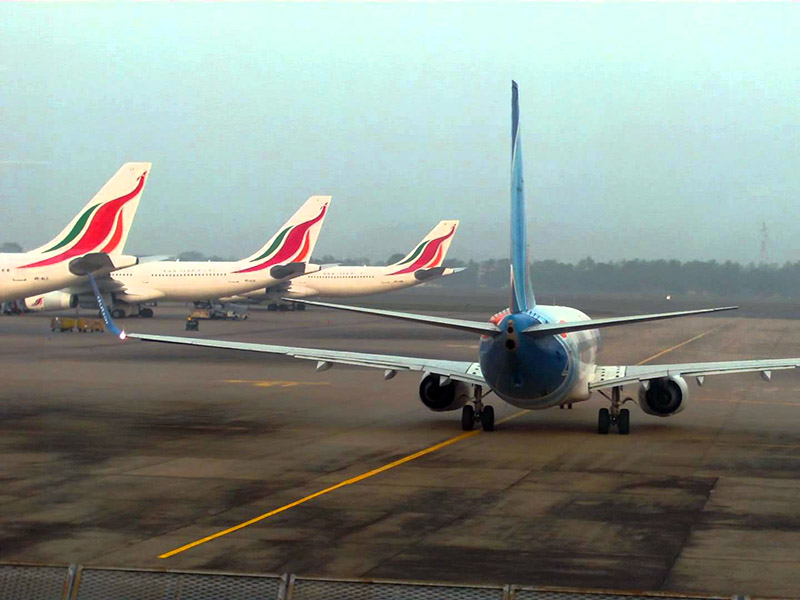
After breakfast at Hotel transfer to Colombo through the Highway
What was once a swamp adjoining the famous Beira Lake, a landmark in the capital city, is today a vibrant complex comprising the Gangaramaya temple, the ‘seema malaka’ – an assembly hall for monks – in the picturesque Beira Lake and a vocational training institute? The temple has been in existence for over 120 years having being established by one of the most famous scholar monks, Venerable Hikkaduwa Sri Sumanagala Nayaka Thera.
In the afternoon, do city tour at Colombo. Colombo is the commercial and business center of Sri Lanka located on west cost. The city blends together with old colonial type building, high-rise commercial buildings and hotels. It is filled with shopping malls. Some of the finest structures built during the colonial times still preserved in one part of the City. For example, there is a 100-year-old clock tower, and the Bandaranaike Memorial International Conference Hall (BMICH) which was a gift to Sri Lanka from the People’s Republic of China.
Welcome the guests at the Airport by a Representative of Aliyah Tours
All Local Transfers and Sightseeing by an air-conditioned vehicle throughout the tour
Entrance Fees for Sights Visited
Visit according to the program
One litter water bottle per day
Highway Tolls
All Local Taxes
Air tickets and insurance
Immunizations / Medical
Meals and accommodation
Video camera permits
Vehicle use for night life activities
Porter rage & Tips
Cost of beverage throughout the tour
Expenses of a personal nature
Any other services not specified above
Client should pay 50% of tour amount at the arrival and the rest can be paid during the tour or at the Airport where you’re ready for the departure.
You should provide accommodation and meals for the driver.
Cancellations within 01 to 06 days of the arrival date – 100% of the value of the booking
Cancellations within 07 to 13 days of the arrival date – 50% of the value of the booking
Cancellations within 14 to 28 days of the arrival date – 25% of the value of the booking
Cancellations beyond 30 days of the arrival date – not charge

